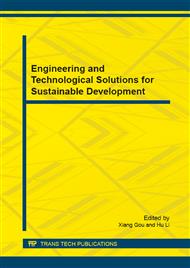p.532
p.536
p.542
p.549
p.554
p.558
p.563
p.568
p.576
Study on Nutrient Characteristics Analysis of Back Soil Area
Abstract:
Nowadays, there is a variety of methods on soil nutrient environment prediction, in order to improve the accuracy of prediction data, more than prediction model can be used. The Jilin province is an important agricultural production area in China. The analysis of the soil nutrition environment is an important theoretical basis for agricultural planting structure. It is play important role to make the food security and agricultural sustainable development strategy. The research results show that the optimal partition number is 8 kinds of nutrient types. From the research results, it can be found the method of principal component and cluster analysis can be successfully applied to classify soils in Jilin province.Not only the partition results can guide sampling, but also provide an important method for accurately predicting the soil nutrition environment in agricultural products.The results can be used to implement variable input and precise fertilization recommendation.
Info:
Periodical:
Pages:
554-557
Citation:
Online since:
November 2014
Authors:
Keywords:
Price:
Сopyright:
© 2014 Trans Tech Publications Ltd. All Rights Reserved
Share:
Citation:


